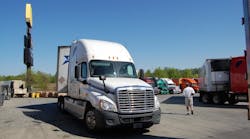The turnover rate at large TL fleets rose five percentage points in the third quarter to an annualized rate of 95%, according to data tracked by the American Trucking Associations (ATA).
Yet turnover at small TL fleets – those with less than $30 million in annual revenue – dipped slightly during the same period, falling one percentage point to an annualized rate of 84%, the trade group said.
ATA added, however, that the 84% turnover rate for smaller fleets in the third quarter this year is two points higher than the same period in 2016.
By contrast, driver turnover for LTL fleets fell two percentage points to 7% for the third quarter, which is the lowest it’s been since the second quarter of 2016, according to Bob Costello, ATA’s chief economist.
“Since bottoming out at the end of 2016, the turnover rate at larger fleets has steadily risen – a function of an improving economy, rising demand for freight transportation and fierce competition for drivers,” he said in a statement.
Costello added that “fierce” competition is pushing wages higher and also fueling fears that the ongoing shortage of drivers will only worsen. In October, ATA released its latest update on the shortage, pegging it over 50,000 by year’s end, with the potential to rise to 174,000 by 2024.
“Unless steps are taken to make it easier for individuals to pursue careers in trucking, demand for drivers will continue to outstrip supply – eventually even leading to supply chain disruptions,” he said.
The turnover rate may also be compounded by an increase in the average age of the truck driver labor pool, which is right now is hovering around 49 years old, some reports showing it’s even older, beyond 50, according to Max Farrell, CEO and co-founder of WorkHound.
“There is not going to be one single thing that solves the driver shortage,” he added during a conference call with reporters hosted by Stifel Capital Markets.
“I currently do believe that pay will have to increase, training will need to be improved as well but also there will have to be some regulatory changes,” he said.
“One of the biggest challenges that the industry faces is that high school grads are graduating at 18 but couldn’t drive a truck across state lines until 21 – but most companies wouldn’t take them until 23 because of insurance purposes,” Farrell noted.
“Right now, I know there [are] some exploratory programs that FMCSA [the Federal Motor carrier Safety Administration] is looking at around how do we either get young people into the industry to drive at an earlier age,” he added. “[It’s about] making accommodations so that we can get more people involved in the industry sooner.”



